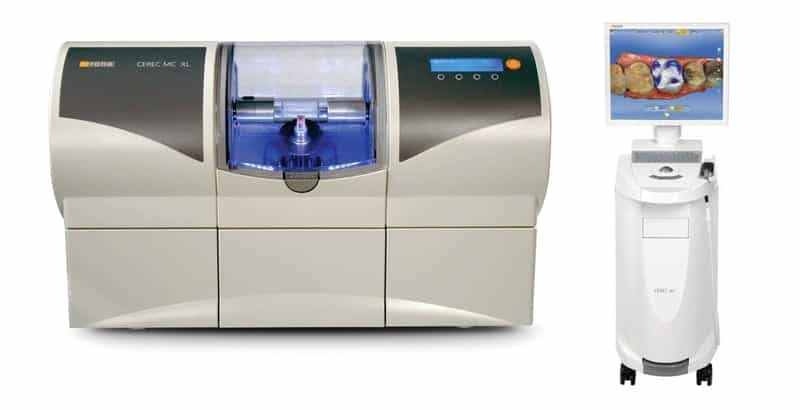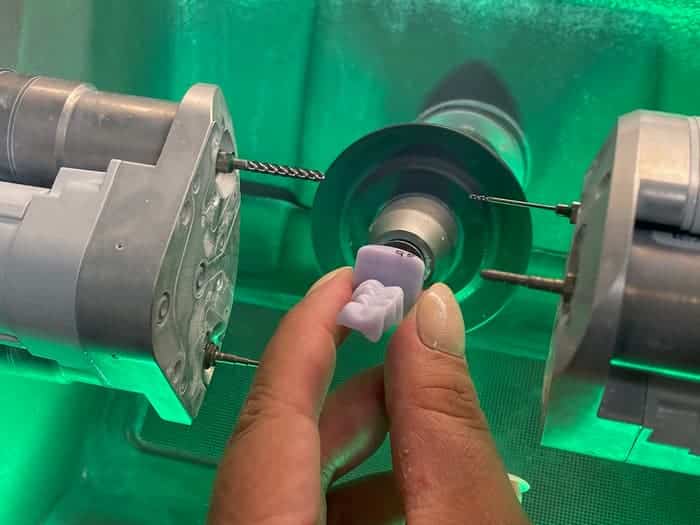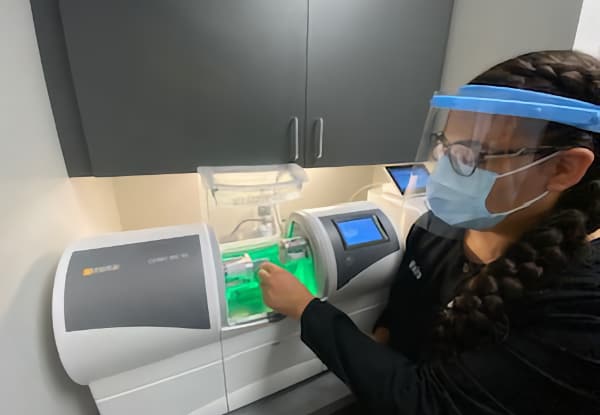
CEREC in Longmont
What is CEREC?
CEREC is an acronym for Chairside Economical Restoration of Esthetic Ceramics. The official name is somewhat technical, but the keyword here is “Chairside.” A CEREC machine allows us to perform same-day custom dental restorations in one visit while you’re in our dental chair. This greatly speeds up a process that typically requires sending a mold of teeth to a lab and waiting several weeks to begin restoration.
How Often Do We Use Our CEREC?
We produce dental crowns, bridges, onlays, and veneers practically every day on our CEREC. In fact, we use it so often that we bought a second one so we can produce multiple devices at a time.
When it comes to using this machine, we’re not alone. According to its manufacturer, Dentsply Sirona, over 6.5 million patients receive CEREC restorations each year.¹ This is approximately 65 times the population of Longmont!
How Does a CEREC Work?
Scan
Dr. Hedrick or Dr. Ryan will log into the CEREC and specify the exact location for the restoration. Afterward, we’ll scan your mouth and create an exact and well-detailed 3D image of it
Design
Designing your new device starts with a CEREC proposal, which is an advanced process that uses not only your tooth anatomy but also the information of millions of other scans in the CEREC database. The proposal’s many details include the exact shade of the device, and Dr. Hedrick may change the proposal if needed.
Produce Restorative Device
After the design is approved, the CEREC will mill your device from a ceramic block, which typically takes 30-60 minutes.
Finishing
The last step involves placing the device into our CEREC Speedfire, which is a small oven-like device that can heat up to 2912 degrees fahrenheit. This process not only strengthens the device but also gives it the desired shade of color.

What Materials are Used with a CEREC?
These machines can use several types of materials for devices, but we primarily use zirconia or lithium disilicate. Zirconia is related to metal, but it’s like a ceramic and is extremely durable. Lithium disilicate is also like ceramic, but it’s more translucent than zirconia, thus, more aesthetically pleasing. For this reason, lithium disilicate is often used on the front teeth, but our doctors can recommend which material selection or combinations are best for you.
How Long Do CEREC Crowns, Bridges, and Onlays Last Compared to a Lab Restoration?
Devices produced in a CEREC are extremely durable, and many studies show that they’re just as durable as those produced in a dental lab.² How long a device lasts comes down to two primary factors:
Dentist Skill
To achieve a high-quality placement, the restoration preparation must be as smooth and exact as possible, which comes down to the hand skill of the dentist. The better the restoration preparation, the longer the device will last.
Patient Commitment
It’s important to take diligent care of your new device. Brushing and flossing every day will increase its lifespan. It’s also important to see us for regular checkups and cleanings.

Benefits of a CEREC
These machines have many advantages over lab-produced restorative devices. Not only do they allow us to create a higher-quality product, but they also make the experience much more convenient for you. Some of the benefits include:
Same-Day Crowns, Bridges, and Implants
Instead of making multiple trips to the dentist’s office, we can create your restorative device while you wait.
No Temporary Crowns
Nobody likes temporary crowns, which don’t adhere strongly to the tooth and require you to avoid certain foods. A CEREC makes them outdated, and you’ll get your crown in one visit.
Digital Scans
Because a CEREC is entirely digital, you can forgo those gooey impression materials
Accuracy
Devices produced with a CEREC are extremely accurate, much more than impression material. In fact, it’s even as accurate as what a lab can produce.
A Guaranteed Perfect Fit
CEREC machines ensure a perfect fit. In the rare event of a defect, we can create a replacement device in the same visit. Lab-created devices that are defective would either need to be returned to the lab to be fixed, causing delays, or we would have to cut and grind it ourselves, which wouldn’t guarantee a perfect fit.
Dr. Hedrick’s Thoughts on CEREC
“The CEREC is the number-one tool in improving the patient-dentist experience. No matter the patient’s age, everyone enjoys watching this machine create their crown or other device.
I take so much pride in my work, and this has allowed me to love dentistry even more. I often jokingly tell patients that if somebody took away my CEREC, I would find a different job.
Another wonderful thing about this machine is it allows my assistant to be such an integral part of the restorative process. We have such an awesome team, and I love to get everybody involved with creating beautiful smiles.”
Why choose Longmont Dental Loft for same day restorations?
If you’re looking for same-day restorations, you’ve come to the right place. We’re passionate about creating devices in our CEREC, and we do it often. As mentioned, our office has not one but two CEREC machines. Our doctors create so many restorative devices that a second machine became necessary.
Just as important as having this machine is being able to perform the procedure properly. Our doctors are highly skilled and will make sure you have a perfectly fitted device.
References
- Dentsplysirona. The CEREC Restorative Workflow. Dentsplysirona.com. Retrieved November 7, 2023 from https://www.dentsplysirona.com/en-nz/categories/cerec/workflow.html.
- Zimmer, S., Göhlich, O., Rüttermann, S., Lang, H., Raab, W., Barthel, C. (2008, September-October). Long-term survival of Cerec restorations: a 10-year study. Nih.gov. Retrieved November 6, 2023 from https://pubmed.ncbi.nlm.nih.gov/18833853/#:~:text=The%20survival%20rate%20was%2094.7,rates%20of%20cast%20gold%20restorations.